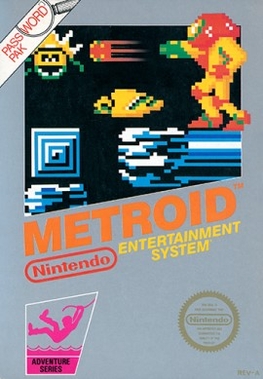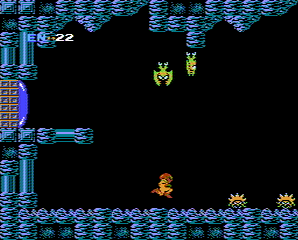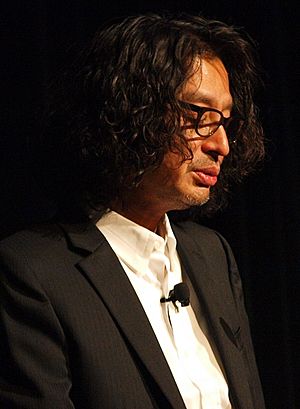Metroid (video game) facts for kids
Quick facts for kids Metroid |
|
|---|---|

North American packaging artwork
|
|
| Developer(s) |
|
| Publisher(s) | Nintendo |
| Director(s) | Satoru Okada |
| Producer(s) | Gunpei Yokoi |
| Artist(s) |
|
| Writer(s) | Makoto Kano |
| Composer(s) | Hirokazu Tanaka |
| Series | Metroid |
| Platform(s) |
|
| Release date(s) |
|
| Genre(s) | Action-adventure |
| Mode(s) | Single-player |
| Arcade system | PlayChoice-10 |
Metroid is an exciting action-adventure game made by Nintendo. It was the very first game in the popular Metroid series. The game first came out in Japan in August 1986 for the Family Computer Disk System. Later, it was released in North America in August 1987 for the Nintendo Entertainment System (NES).
In Metroid, you play as Samus Aran, a brave bounty hunter. She goes to the planet Zebes to find special creatures called Metroids. These Metroids were stolen by evil Space Pirates. The Pirates want to use the Metroids as dangerous weapons. Samus must stop them and destroy their leader.
This game helped create a new type of game called "Metroidvania". These games focus on exploring a big world. You find power-ups that let you reach new areas. Metroid was also one of the first games to have a female hero. It became popular for "speedrunning," where players try to finish the game as fast as possible.
Metroid was very successful. People loved its graphics, music, and controls. It has been re-released many times on different Nintendo systems. These include the Game Boy Advance, Wii, Wii U, 3DS, and Nintendo Switch. An updated version, Metroid: Zero Mission, was released in 2004.
Contents
Explore Planet Zebes: Gameplay Basics
Metroid is an action-adventure game where you control Samus Aran. You explore a large, open world on the planet Zebes. This world has many caves, connected by doors and elevators. Samus starts with a basic weapon and can only jump.
As you explore, you find cool power-ups. These power-ups give Samus new abilities. They also make her armor and weapons stronger. With new powers, Samus can go to places she couldn't reach before. Some key power-ups include:
- Morph Ball: Samus can curl into a small ball. This lets her roll into tight tunnels.
- Bomb: You can use bombs only when in Morph Ball form. Bombs can open hidden paths in floors and walls.
- Screw Attack: This move makes Samus spin. She destroys enemies that touch her while spinning.
Defeating Bosses and Getting Stronger
Besides regular enemies, Samus faces two big bosses: Kraid and Ridley. You must defeat them to move forward in the game. When you destroy normal enemies, they often drop energy or ammo. You can also find special tanks to increase Samus's energy and missile capacity.
Once Kraid and Ridley are defeated, their statues open a path. This path leads to the final area. There, Samus confronts the main boss, Mother Brain.
The Story of Metroid: Stopping the Space Pirates
The story begins in the year 20X5. Space Pirates attack a research ship. They steal samples of Metroid creatures. Metroids are dangerous parasites found on planet SR388. They can attach to other living things and drain their life energy.
The Space Pirates want to use Metroids as weapons. They plan to make many more Metroids using special rays. Then, they will use them to destroy anyone who opposes them. The Galactic Federation finds the Pirates' base on planet Zebes. They try to attack, but the Pirates are too strong.
As a last hope, the Federation sends one bounty hunter. This hunter must go deep into the Pirates' base. Their mission is to destroy Mother Brain. Mother Brain is a powerful computer that controls the Space Pirates' fortress. Samus Aran, the best bounty hunter, is chosen for this dangerous mission.
Samus lands her ship on Zebes. She explores the planet's caverns. Along the way, she finds many upgrades. These include missiles, energy tanks, the morph ball, bombs, and the ice beam. She uses these to defeat alien creatures. Samus defeats Kraid and Ridley, two powerful Pirate allies. Finally, she destroys the Metroids and Mother Brain. A timed bomb then goes off to destroy the lair. Samus escapes just before it explodes.
Creating Metroid: How the Game Was Made
After making popular games like Donkey Kong and Super Mario Bros., Nintendo started working on Metroid. The name "Metroid" is a mix of "metro" and "android." The game was made by Nintendo Research & Development 1 and Intelligent Systems.
The team wanted Metroid to be different. They made it a nonlinear adventure game. This meant exploration was very important. Players had to go back and forth to find new paths. Metroid was one of the first games to make players feel alone and desperate.
Samus's Secret: A Female Hero
During development, someone on the team had a cool idea. "What if the person inside the suit was a woman?" This idea was added to the game. However, the English game manual still used "he" for Samus.
After you defeat Mother Brain, the game shows one of five different ending screens. Which ending you see depends on how fast you finished the game. In some endings, Samus takes off her suit. This is when players first learn that Samus Aran is a woman! This was a big surprise and made the game special.
Game Saves and Music
The Japanese version of Metroid used Disk Cards. These allowed players to save their game in three different slots. For the international release, a new password system was used. Players had to write down a 24-letter code to continue their game later. These codes also allowed for cheats.
The game's music was created by Hirokazu Tanaka. He wanted the music to feel like a "living organism." He made the music very simple, not like catchy pop songs. The only time you hear a clear melody is after you defeat Mother Brain. This helps you feel the joy of winning.
Game Release and Modern Access
Metroid was first released in Japan on August 6, 1986. An arcade version came out in 1987. It then came to the Nintendo Entertainment System in North America in August 1987.
Playing Metroid Today: Emulation and Remakes
Metroid has been re-released many times. This means you can still play it on newer systems.
- You could unlock the original Metroid on the GameCube by linking it to Metroid Fusion on the Game Boy Advance.
- It was also a bonus game in Metroid: Zero Mission.
- A special version for the Game Boy Advance was released in 2004.
- It came to the Wii, Wii U, and 3DS through their Virtual Console services.
- It is also available on the Nintendo Switch through its online service.
The game was also remade as Metroid: Zero Mission. This remake has updated graphics and gameplay. It also adds more to the story, but keeps the same general game layout.
Images for kids




